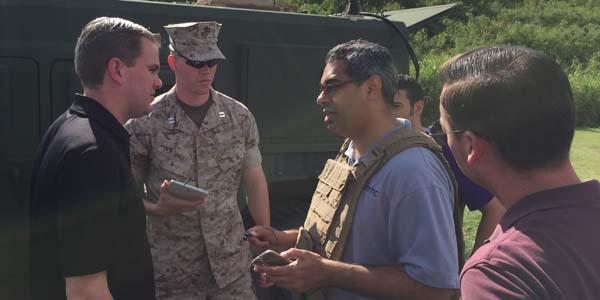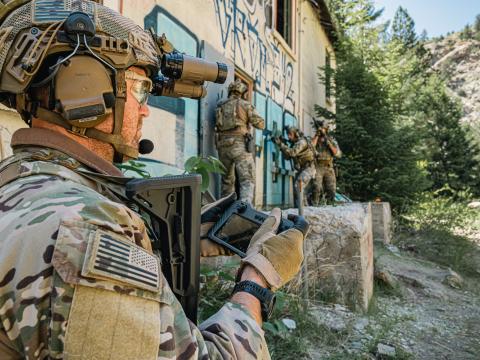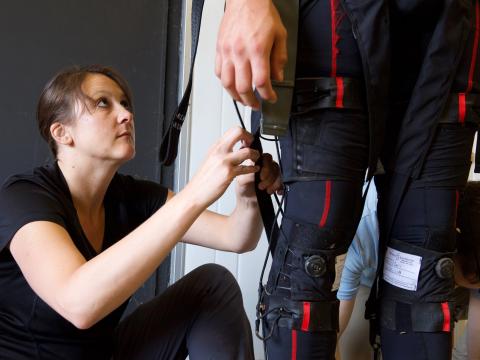Marine Corps Returns to Its Expeditionary Roots
Thirteen years of sustained U.S. combat troop presence in war zones overseas compelled the U.S. Marine Corps to set aside its expeditionary nature and dig in alongside its U.S. Army counterpart for long deployments and occupying missions. The longest war in U.S. history—the Afghanistan War—had Marines conducting yearlong assignments to expunge terrorists, train foreign armies and security forces and help rebuild nations torn apart by the punishing battles.
Today, as U.S. combat missions wind down in Afghanistan and the U.S. troop presence in Iraq, for now, is delegated to advisers alone, a part of the sea service is reverting to its origin as the nation’s expeditionary force in readiness established in 1775. And research is spearheading that effort.
“We’re basing everything on the Marine Corps getting back to its expeditionary roots,” says John Moniz, a program manager at the Office of Naval Research (ONR). “We’re developing everything with that understanding. Everything we have has to be moved from sea to shore, inland at some point, and everything we develop has to support that mission. ... We’re working in that type of scenario.”
No shortage of work exists for ONR scientists and engineers, who are testing a gamut of programs and technologies to help Marines and sailors combat an ever-morphing adversary and catch up with technological advances that outpaced naval expeditionary operations. These operations now involve more sensors, radios and computers than ever before.
One such method is through efforts of the Expeditionary Maneuver Warfare and Combating Terrorism Department, developed jointly by the ONR and the Marine Corps Warfighting Laboratory to advance and transition technologies that will better enable the Navy-Marine Corps team of warriors in areas of command, control, communications and computers (C4); force protection; human performance training and education; intelligence, surveillance and reconnaissance (ISR); logistics; and maneuverability. The department invests primarily in the areas of expeditionary and irregular warfare, autonomy and unmanned systems and information dominance.
Each year since 2011, ONR sponsors a technology demonstration dubbed Agile Bloodhound, an event to help scientists and officials from the acquisition community get an early look at undeveloped technologies and assess the feasibility of integrating those capabilities into various portfolios, Moniz says. “We really take some fairly immature technologies and try to put them together and show where we’re going with these technologies, how they can potentially fit into acquisition systems and show the overall capabilities we think we will be able to deliver in a few years,” Moniz states. “We started out trying to do this with ... what we call ISR to C2 [command and control], where we’re trying to more quickly take information products that are being generated by sensors ... and move them more quickly to the warfighter to give them more timely information. We’re looking at a whole bunch of different technologies, integrating them together and then trying to show some larger capability sets for our acquisition people and warfighters.”
Showcased technologies come from industry, academia and those developed inside government labs. “We’re putting all those pieces together,” Moniz adds. The annual event, which also brings in the Marine Corps Forces Pacific Experimentation Center in Hawaii, continues to expand in scope.
“[After] it started out ISR to C2,” Moniz explains, “then we added in some of the human social-cultural behaviors that civil affairs people on the ground use to understand what are the needs of the populace, what’s the state of the infrastructure and things such as that. We brought those tools in in 2012. In 2013, we actually started basing things on the Marine Corps’ C2 and communications architecture so that we could show more fidelity to our stakeholders in the acquisition community.
“This past year, we brought in logistics to try to improve situational awareness and bring in some automated tools to speed up and improve the logistics process. [In 2015], we’re discussing if we want to bring in weapons and targeting information and try to integrate that as well,” he continues. “We haven’t made that decision yet, but that’s one thing that we’re discussing at this point, making targeting decisions better and faster by bringing in information and processing some of the target identification process so we can speed up that process of deciding whether to execute and how to execute it.”
The testing dovetails into the much larger Corps migration to a knowledge-based force, moving from a net-centric to a data-centric strategy that leverages seamless communications and extends warfighting into cyberspace. Officials hope to capitalize on readily available, off-the-shelf technology, which when tweaked to conform to military security standards, can help troops automatically sift through a lot of data to ease the information overload and deliver to the front lines needed intelligence at much faster speeds.
Additionally, the Navy is developing a laser weapon that could be mounted on and fired from Humvees or other tactical vehicles to shoot down unmanned aircraft. The Ground-Based Air Defense (GBAD) Directed Energy On-the-Move system meshes with the sea service’s efforts to be more expeditionary. The United States has achieved extensive capabilities in militarized unmanned assets, particularly aerial platforms. Over the years, technology has become less expensive and easier to attain, and unmanned aerial vehicles (UAVs) rapidly are becoming part of other nation-states’ military inventories and acquired by groups and nongovernment factions, including terrorist groups, according to a Rand Corporation publication dating to 2008 that explored the proliferation of both UAVs and cruise missiles. “The U.S. military has demonstrated its utility in modern combat in many recent conflicts. Therefore, it should not be surprising that cruise missiles and UAVs increasingly are entering the inventories of militaries around the world and even those of some terrorist organizations,” the document reads.
The U.S. military for several years has sought technology to counter not only the lethal menace posed by armed drones, but the surveillance technologies aboard hostile unmanned aircraft. The GBAD system is expected to offer a low cost-per-shot capability to expeditionary Marines and thwart potential enemy targeting done by airborne UAVs. “We’re confident we can bring together all of these pieces in a package that’s small enough to be carried on light tactical vehicles and powerful enough to counter these threats,” says Brig. Gen. Kevin J. Killea, USMC, vice chief of naval research and commanding general of the Marine Corps Warfighting Laboratory. The GBAD-related technologies fall under the 2012 U.S. Marine Corps Science and Technology Strategic Plan, which calls for a mobile directed-energy weapon capable of destroying threats such as those posed by hostile UAVs.
The Future Naval Capabilities program is the mammoth science and technology effort designed to transition cutting-edge technology products to acquisition managers, usually within a three- to five-year time frame. Efforts fall into areas of manpower, enterprise and platform enablers, expeditionary maneuver warfare, force health protection, power and energy and FORCEnet, or the overall operational construct and architectural framework that will let naval warfare thrive in the information age.
Some programs are expected to be funded this year. For example, the Advanced Topcoat System is a high-performance, nonisocyanate topcoat that can be applied to systems along with advanced protection primers to significantly reduce maintenance costs and increase the life of aircraft and ground vehicles. The Combined EO/IR Surveillance and Response System is being developed as an electro-optic/infrared surveillance and response solution for use on surface ships. It is designed to surround the entire kill chain of threat detection, identification, tracking, engagement and assessment of engagement effectiveness.
Other examples include the EW Extended Endurance Decoy, which will provide a ship-launched, rapid-reaction, long-endurance, expendable flight vehicle designed to carry electronic warfare payloads. And Reactive Electronic Attack Measures will deliver detection and classification techniques to identify new or waveform agile radar threats and automatically respond with an effective electronic attack.




